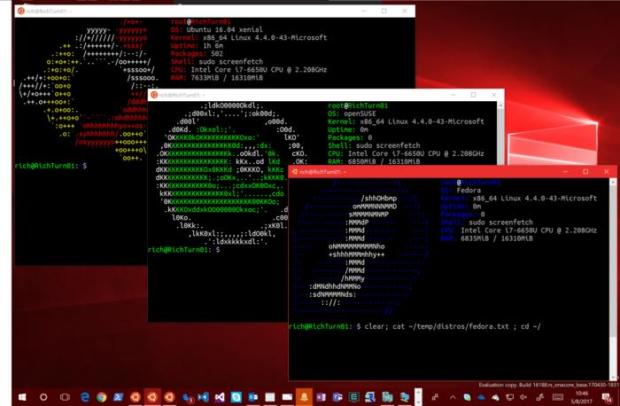I’m a Linux user. And, as the old adage goes, “I don’t do Windows.”
This is not an article about how Linux is superior to Windows. Truth be told, I don’t begrudge any person’s choice of computing environment—be it Windows, Mac, BSD, Amiga. What each person uses is truly up to them. Me? I use open source. I use free software. I use Linux.
So, what then, do I make of Microsoft’s Windows Subsystem for Linux aka WSL?
For those unfamiliar, the WSL is basically a compatibility layer within Windows 10 that allows you to run Linux binaries. The end result is that you can run a full Linux shell, complete with Linux terminal applications, on a Windows PC.
At Microsoft’s Build conference last week, the company announced that WSL is being expanded and improved upon. Specifically, it now makes multiple Linux distributions available (Fedora, openSUSE, SUSE Linux Enterprise and Ubuntu) and able to run simultaneously on the same Windows machine.
No joke. If you have Windows 10, you’ll soon be able to run a BASH terminal with openSUSE, Fedora and Ubuntu—all at the same time. I repeat: In Microsoft Windows.
Crazy, right?
But what do I, a guy who hasn’t used Windows in years (other than to poke at it in a computer store), do with this? How does this impact my life or the world around me?
Truth be told, this doesn’t directly impact my daily computing life at all. Not even a teensy, tiny bit.
I’m still a Linux and free software user. And as such, the ability to run a nice Linux instance on Windows—while definitely cool—isn’t enough to get me to switch away from running a full Linux distribution on bare metal. There’s no real benefit for me there.
But this wasn’t meant for me—or others like me who live in Linux all day.
 Windows-dominant organizations will benefit
Windows-dominant organizations will benefit
Where I see this being really useful is for folks who work at a company that requires them to run Microsoft Windows. Those people now have access to a huge stack of Linux software in a much easier way than before.
And since these Linux distributions are being added to the official Windows Store app (no joke, you’ll soon be able to install various Linux distributions from the Windows Store), the odds of company IT departments being okay with people installing “Linux” on their machines goes up significantly.
I’ve heard some people speak about this with some concern—that this is some sort of play by Microsoft to win over Linux users and bring them to Windows. Honestly? That doesn’t seem like what’s happening here. If that were Microsoft’s goal, this would be a strange (and ineffective) way to accomplish it.
No. I think this is Microsoft realizing the reality of the marketplace. Developers and sys admins use Linux—all the time. And by fully embracing multiple Linux distributions running right on top of Windows, Microsoft is increasing the usability and viability of their platform within organizations that also contain Linux servers and workstations (which, at this point, is just about every organization on Earth).
It’s a smart move on Microsoft’s part. It is, in some ways, reminiscent of what Wine (the Windows compatibility layer) accomplished with Linux—providing a way for Linux users to be able to run Windows applications, thus making life easier in a Windows-dominated organization. Now, Windows can do (somewhat) the same thing within organizations dominated by Linux servers and workstations.
It may not win over a bunch of Linux diehards (like me), but it’ll sure make life easier for many. And that seems like a good goal for everyone.
Plus, there’s the, in my opinion, pretty major upside for Linux and free software folks: This is one of the best ways to “sneak” free software into an organization that I’ve seen in quite a long time.
The easier it is to install, run and support Linux-based software across an organization, the easier it is to build infrastructure, systems and practices that rely on said software. As the usage of Linux software increases, the attractiveness and viability of moving more systems to Linux also increases—thus making the Windows Subsystem for Linux one of the greatest Trojan horses in computing history.
Plus, as more people use the WSL, those free and open source components become a critical part of their Windows experience, hus increasing Microsoft’s usage of, and dependence on, free software. And that seems like a huge win for absolutely everyone—including Microsoft.

Working as a cyber security solutions architect, Alisa focuses on application and network security. Before joining us she held a cyber security researcher positions within a variety of cyber security start-ups. She also experience in different industry domains like finance, healthcare and consumer products.











